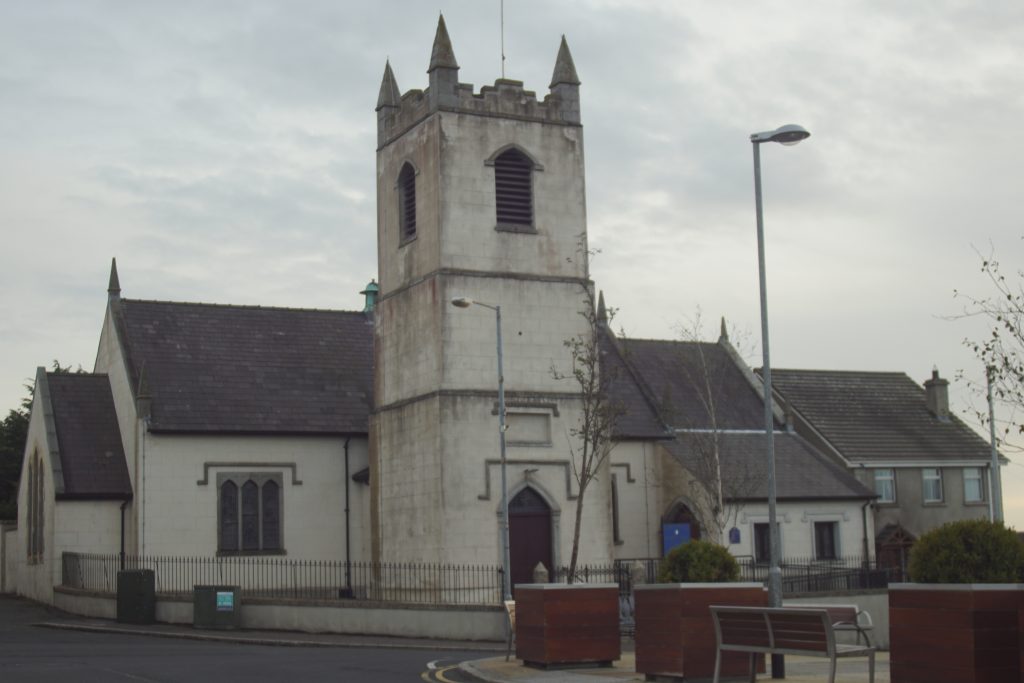St John’s Church of Ireland – Drumgath Parish

The old Parish Church of Drumgath was in the townland of that name, but no trace of the building now remains. The ancient graveyard attached to the church is still used as the burial place of some of the older families in the district.
In an Inquisition of 1657, it was found that – “Drumgath Parish anciently a rectorie and by the said erection made part of the Treasureship by which the Treasurer enjoyed the Gleabe all Tythes and Duties, which in the year 1640 was of the yearly value of twenty pounds, at present worth fifteen pounds. Contayning nyne towns and three quarters, the Curé served at present by Mr Heutson aforesaid, the parish Church neare the middle wholly ruinated, the furtherest part of the parish being two miles distant from the Church. One quarter of the said lands is called Drumgath the Gleabe now being worth two pounds yearly, but in the year 1646 worth two pounds ten shillings yearly, the Parish bounded with Clonallen Parish on the South, Newry Parish on the West, Drumballyroney Parish North, and Clonnuffe Parish East. Tythes payable in kind and duties as aforesaid, the profits of the Tythes and Duties since the Rebellion having been answered and paid for the use of the Commonwealth, the late Bishop of Dromore patron of the said Treasureship.”
The present church with its adjoining graveyard situated on the south side of the Square (otherwise Church Street) was erected by Robert Hawkins Magill about 1730 and consecrated for worship on 13 September 1733. Prior to this, many of its parishioners were buried in the ancient graveyard at Drumgath. (See later note about this site) It was dedicated “To the Glory of God and for the greater convenience of the neighbours.” On the same day what is known as the “Old Graveyard” was consecrated. The Communion Plate, which is still in use, was the gift of Robert Hawkins Magill. It consists of a silver Chalice and Paten each bearing the inscription “Presented to Rathfriland Parish Church by Robert Hawkins Magill Esq, 1733.”
With the passing of the Tithe Commutation Act in 1836 tithes were added to the rent. Tithes were abolished with the disestablishment of the Church of Ireland by the Irish Church Act in 1869.
Rev Blackburn collected most of the churches’ histories used in this booklet.
St John’s Church, erected by Mr Magill consisted chiefly of the nave, the chancel, transept with gallery having been added since, probably when the church was enlarged and improved in 1818. The former Glebe House dating from 1807 and built by Richard Newsam was situated on the East side of the Square and was demolished when the former Belfast Bank was erected. The Glebe lands in Cross were acquired by Mr William Fegan, father of the late Mr John Fegan, Kiltariff Hall.
After the death of Rev Robert Oswald, Vicar of Drumballyroney, in 1901, the Parish was united with that Parish, and the Vicars of the united Parishes lived in Drumballyroney Rectory, until it was sold after the death of the Rev H Blackburn, now the home of the Hall family.
In 1933, just before the 200th anniversary of its erection, a new roof was put on the church. In 1954 the Harmonium then in use was replaced by an electric organ. This organ was erected “to the glory of God, and in grateful remembrance of those from this Parish who served in the Second World War 1939-1945” by the Parishioners.
On 14 January 1968, the Right Reverend FJ Mitchell DD, the Lord Bishop of Down and Dromore, held a special service of Thanksgiving to mark the re-opening of the Church after the completion of major renovations. The Bishop also dedicated a number of memorials and gifts for the adornment of the church. The renovations cost over £3,500 and were paid for by direct giving of the parishioners themselves, no special function to raise money of any kind having been held.
